Bands of melancholy blue bleed across and down; soft and sudden rivulets of oil find their secret, yet random way. One feels nature being disclosed to it-self, the paint breathing with delicate, subconscious power. A build up of dark paint crud, coarsened with various ground substances acts as a permeable wall, both allowing and disallowing the flow, accentuating a sense of both atmosphere and terrain. All is mood, movement, matter. Nowhere do solid forms intrude.
This is the compositional world of Michael McSwiney, an Irish artist comfortable in his skin, mature in his language and alive with the creative substances that drive him.
First impressions of his recent exhibition at the Doswell Gallery, West Cork elicit a multitude of one-word / phrasal utterances, and much like the artist’s own process of beginning it is as good a place to start as any: flows, stops, build-ups, blooms, flares, signs, pores, fractals, rivulets, archaeology of surface, matt and gloss, pictographic, topographic, cosmic strata, anarchic surface, spray drops, stencil signs, coarse, delicate, wash, crud, star, lost, hidden. The ‘one-word utterances’ are fragmented associations, a ground perhaps from which to build.
And to build what? Something, one hopes, of a verbal equivalence or resonance, a resonance to aid an enquiry into the mystery of the process, into the mystery of composition itself. To this end the writer is aided by the artist’s own verbal associations and poetic resonances, sounded through his titles: Salonica, Moon-age Daydream, Rusted Horizon, Solano, Under Plimsoll Skies, The Iron Sea, Manna, Heart of the Moon. Titles such as, ‘Rusted Horizon’, Plimsoll Skies’ and ‘Iron Sea’ breathe the program of trans-substantiation at the heart of the artist’s vision. Playing upon both the sea-scape horizon line and the linear edge of rusted dock walls and ship hulls, the two become metaphorically one: the rusted iron wall and the atmospheric sky. The conflation of the two is deeply poetic as it binds the artist’s twin fascinations, of close, physical corrosion and distant, swelling vistas. The distant horizon becomes close – close as a sea wall, and the close wall recedes, until it is a wall no more.
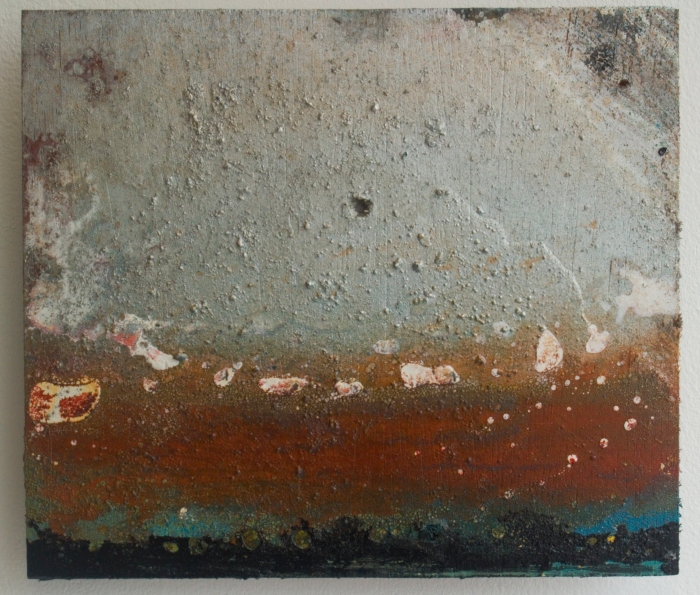
Rusted Horizon
‘Rusted Horizon’ is a small piece, one of many in the Doswell show, that grew, as McSwiney says, from the over-spill of the larger pieces. Several monumental paintings from the year before, shown at the Grainstore, Ballymaloe, show the convergence of sky and wall to much more mesmerizing effect. ‘Under Rusted Skies’, shown in Ballymaloe, is a veritable storm of rust-coloured accretions threatening to engulf a dark ‘headland’ and light coloured ‘shore’. ‘Sea of Time and Room Enough’ is even more substantive, the seemingly random build up of paint in the ‘sky’ rough and electric, poised between sonorous blues, aquas, peaches and russets, with a long razor-sharp line delineating the dark band of the ‘sea’. The tableau feels as if this ‘wall’ of a ‘sky’ has been accreted, peeled and corroded over an aeon.
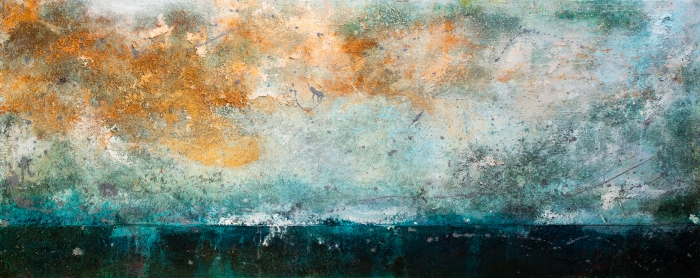
Sea of Time and Room Enough
If ‘Rusted Horizon’ and its ilk conflates wall and vista in a general, poetic sense, ‘Under Plimsoll Skies’ does so in far more explicit, symbolic terms. According to the U.S. National Ocean Service, the Plimsoll line “is a reference mark located on a ship’s hull that indicates the maximum depth to which the vessel may be safely immersed when loaded with cargo.” (oceanservice.noaa.gov/facts/plimsoll-line.html)
In ‘Under Plimsoll Skies’ McSwiney attaches a vertical row of small wooden Plimsoll bars to the canvas in the area of the ‘sky’. The ‘sky’ itself now has a Plimsoll line. The deep beauty of the idea lies in the paradox of a solid ethereality. The paint itself bares this out: rivulets of industrial silver run dreamily across the surface over layers of cream, beige, aqua and mauve. The dark band below (perhaps a churning sea?) throws up a spray of dark, black matter. The effect is airy and liquid, the reality is solid, as a cooled liquid remnant must be.
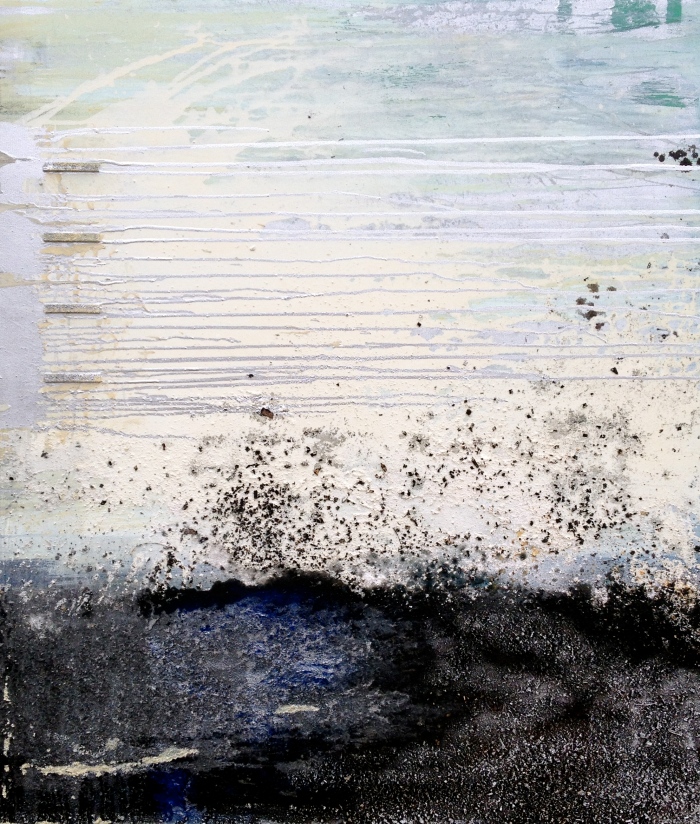
Under Plimsoll Skies
This language of matter invites a third aspect to the metaphoric layers of wall and vista: the accreted canvas itself, the physical trace of the artist’s action, which gives rise to the other two. The accretion on the canvas becomes, by reference, sea, sky and wall – and from the wall returns to itself. The references amplify the aesthetic magic of the accretion. And the accretion, of course, comes first. It is a seemingly boundless language of pours, sprays, cracks, blooms and bleeds, a drizzle of water into oil leaving a harvest of subtle spheres, an erosive blast of white spirits gouging a skin of paint, revealing, peeling; a shower of sand and coffee grounds, a sudden sledge of cadmium red, a spray of silver. The actions, by McSwiney’s admission, are fast, flowing, in the moment. The heavy layering, however, allows the eye to dive deep, to be held, hypnotized.
And so we have a trinity of planes, both metaphoric and actual: the corroded iron plate of the ship or dock wall, the vast vista of sky and sea and the tableau of paint, by turns viscous, flowing and encrudded. As a trinity the planes are never separate; they are discerned within each other, can never be really pinned. The power of McSwiney’s work lies in this ever-shifting ambiguity.
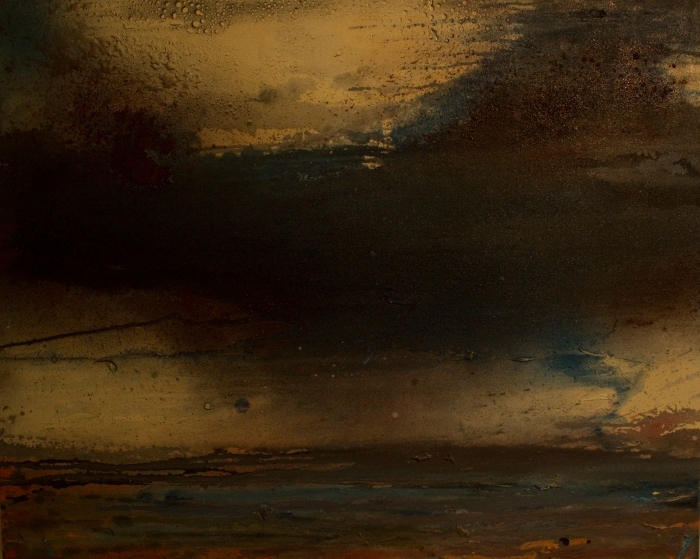
‘Under Rusted Skies’, 2016. One can see in the upper area of the panel the beautiful residue effect of water sprayed into oil.
Like the tide, ever present in the artist’s coastal-dwelling life, there is much in McSwiney’s work which recurs. Recurrence of theme, motif, format and even title reinforce the natural cyclic rhythms, which compel and propel the compositional drives of the artist.
Taking some of the titles from the Doswell show, we find that ‘All at Sea’, ‘Drifting’, ‘Sky over Abandoned Land’, ‘Harbour Skies’, ‘Time and Tide’, ‘Guiding Light’, ‘Under Rusted Skies’ and ‘Manna’ are all recurring titles from the previous year’s showing at the Grainstore, Ballymaloe. Of these ‘Drifting’, ‘Guiding Light’ and ‘Manna’ are the major pieces, the others being quite small, though no less luminous and alive. ‘Guiding Light’ well deserves its title. It shimmers with fluidity and drizzle; everywhere is motion, movement, spray, fractal. Water drops have left their mark in oil, spray has stippled and fractalized the surface. The colours are delicate, light over dark. It is a work of atmospheric presence, by a painter intimate with the sea.
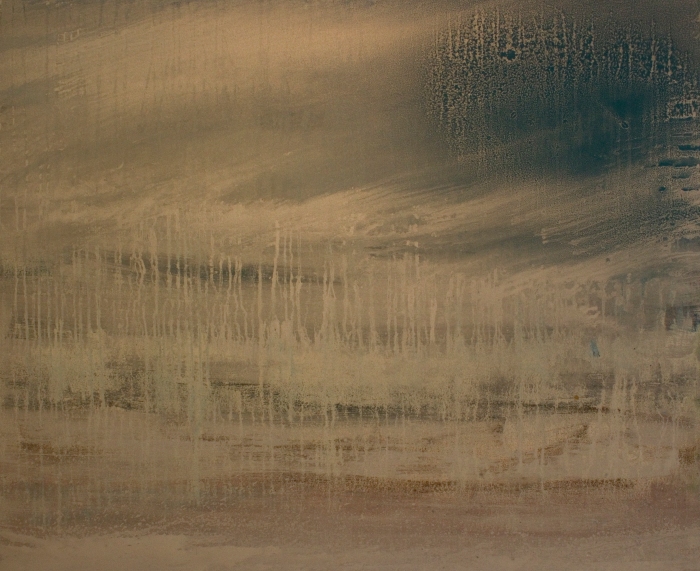
Guiding Light
‘Manna’, by contrast, has a more contained sense of ether and a greater air of solidity. Spherical blooms of luminous ochre cluster dreamily against a dark umber and orange ‘sky’, above a ‘ground’ of earth-reds, umbers and blacks. The effect is not unlike batik, where the clusters of ‘manna’ feel like they have bled into the ‘sky’. There are technical secrets at work here; the image feels like it has ‘arrived’ out of some secret space. One could never contrive it, it has happened and the process of happening is at once both hidden and full of invitation.
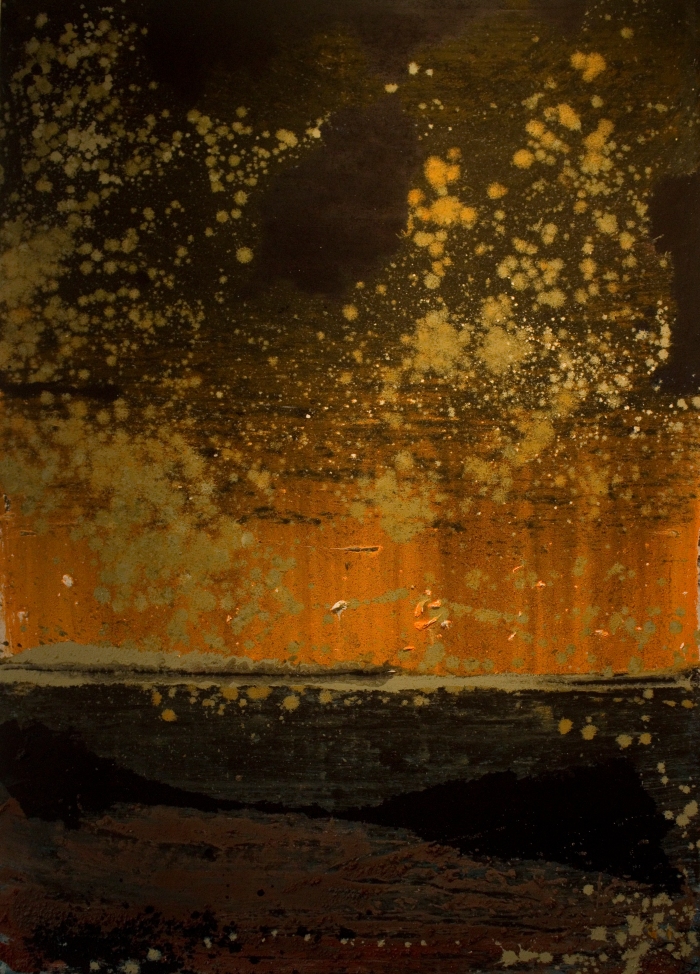
Manna
The title is from the Christian Bible, which describes the ‘manna of heaven’, flakes from the sky that were made into a kind of bread to save the Jews in their hour of need. As it says in the New Testament: “Our fathers did eat manna in the desert; as it is written, He gave them bread from heaven to eat.” John 6:31
The ‘manna from heaven’ has been a strong theme in the history of Western Biblical painting and has only really survived as a contemporary narrative through the work of the German artist Anselm Kiefer, an artist McSwiney greatly admires. The Irish artist’s preoccupation with ‘manna’ could be, perhaps a subconscious echo from Kiefer’s alchemical haunting of the Christo-Judaic myth. The similarity between the creative processes and pictorial approaches, to an extent bears this out. If this is the case, then it is a deeply personal echoing, resonating with the artist’s own unique ‘sound’; for manna is spiritual sustenance, the very energy of art.
McSwiney has scaled down, markedly from the previous year’s showing at Ballymaloe, a factor driven no-doubt by the local market (the artist only recently having moved to West Cork) and by the spatial constraints of local galleries. ‘Drifting’, the third recurring title mentioned above, echoes a much larger piece shown previously in Ballymaloe. The earlier piece has a greater solidity and monumentality, reminiscent once more, of Kiefer’s monumental tableaux of land and sky. The Doswell piece is thinner, more effervescent; its vertical lines bleed out like a watery stenograph. Vertical silvers and whites are crossed with a sledge of cadmium red. The contrast is sudden and vital, yet the piece lacks the monumental build-up of its forebear and doesn’t hold the eye as deeply as ‘Manna’ or ‘Guiding Light’.
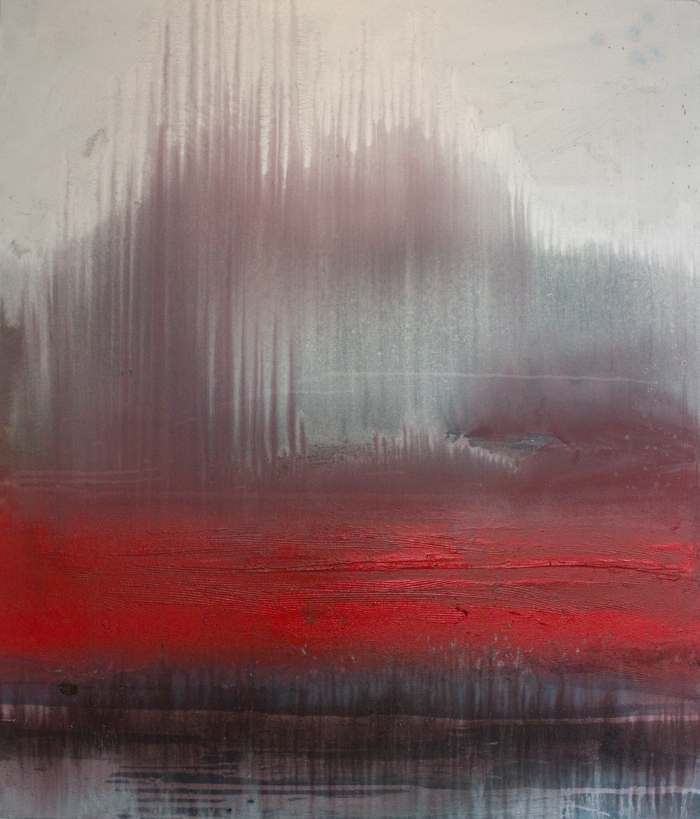
Drifting
One painting which does hold up, against any of McSwiney’s previous canvases, is the monumental ‘Heart of the Moon’. It is, one might say the heart of the recent collection, a gem which all the other pieces converge towards. Bands and zones of sunset orange, russet and cerulean are glazed over with earthen umber, the vital colours flashing, yet made somber, like embers seen through a dirty window-pane. Off-centre a flash of semi-spherical white has been horizontally broken and streaked, its moon-like phosphorescence giving rise to the title. The ‘ground’ is set by a dark ‘horizon’ which whitens towards the bottom of the plane, ‘reflecting’ the white of the ‘moon’.
‘Heart of the Moon’ is a piece which epitomizes the artist’s position as a Contemporary Romantic, fundamentally more Rothko than Kiefer, more Turner than Tapies; an excavator of wordless mood and matter-memory, a weaver of elemental shrouds in which the world’s stories are largely hidden. There is a dark edge to his language of blooms and cracks and flows, a sonority born of depth. But in the darkness there is also a delicacy, a sensitivity to the invisible, to which any true art is but a door.
It will be genuinely interesting to see where McSwiney goes from here, as the artist himself muses, “how long will I keep painting ‘horizons’?” Anselm Kiefer has managed it for a life-time, though he has done a lot more besides. But McSwiney is not Kiefer, and only he can answer that question.
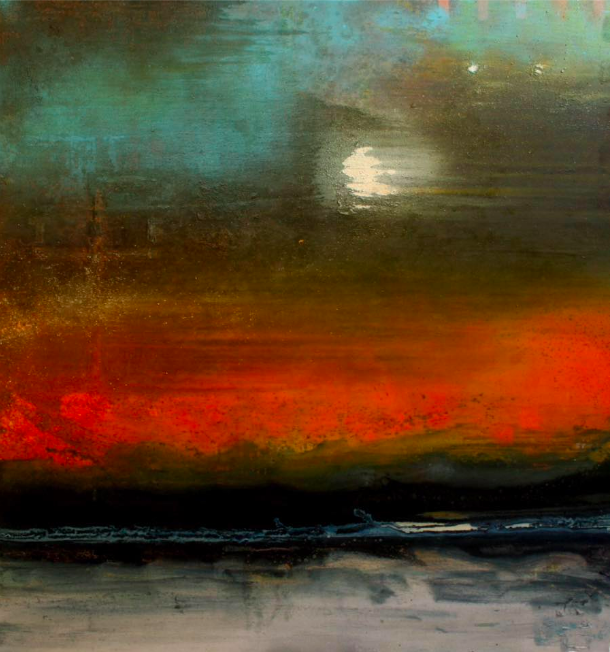
Heart of the Moon
Article by James Waller www.jameswaller.org



Wonderful review. I was also at the exhibition and I think this article evokes the mood of Michael McSwiney’s work beautifully.
LikeLike